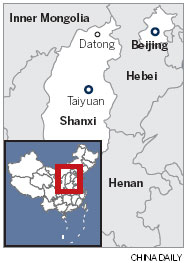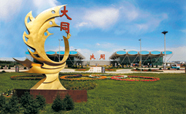Datong prepares for movement of shantytown dwellers
Wandering through the old city of Datong in Shanxi province is a dramatic and diverse experience.
One can visit the Huayan Monastery or the Shanhua Temple, both of which are more than 1,000 years old, listening to the peaceful Buddhist chants and inhaling the fragrance of incense and burning sandalwood.
However, step out of the temples and walk 100 meters toward the city and the air is filled with the sound of cranes working and dust.
|
 |
In the past five years, more than 10,000 of the households living in the shabby bungalows that dominate the 3.28-sq-km old city have moved into new apartments. The new dwellings, just 3 km from the former homes, are part of large-scale government-subsidized housing project, according to Yang She, the head of Datong's housing administration bureau. A further 15,000 households are expected to move within the next few years, he said.
Han Haiyan used to live with her husband and son in an 18-sq-m bungalow in the old city, but last year, they moved to a new apartment measuring 67 sq m. The new home cost just 15,800 yuan ($2,530).
"When I lived in the old city, I was always concerned about heavy rainfall, because the water would run into my room and we had to spend hours mopping up and clearing the water once the rain stopped," said Han, 47.
The project isn't just about the demolition of dilapidated and unsanitary housing, but is also intended to promote renovation and protect a historic part of the ancient city, said Liu Mingjun, deputy chief of Datong's urban and rural planning bureau.
"It would be hypocritical to allow the residents to live in such poor conditions simply in the name of preservation of cultural relics. But it would also be stupid to tear down everything that tells the history of the city," Liu said.
According to the government's plan, about 50 courtyards of great historical significance will be renovated in strict accordance with the original style. They will be used as exhibition centers and museums.
There will be some minor changes to the structures of roughly 300 of the courtyards, because of erosion and other damage that is difficult to repair. The houses will be fitted with modern facilities, such as heating and running water, and will be sold as commercial residential properties.
The rest, accounting for around two-thirds of the buildings, were constructed during the past few decades and have no historical value. They will be demolished to make way for new courtyards that will contain amenities such as shops, restaurants and tea houses.
Copyright 1995 - 2010 . All rights reserved. The content (including but not limited to text, photo, multimedia information, etc) published in this site belongs to China Daily Information Co (CDIC). Without written authorization from CDIC, such content shall not be republished or used in any form. Note: Browsers with 1024*768 or higher resolution are suggested for this site.

